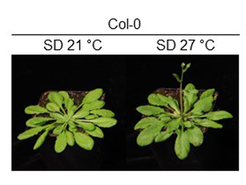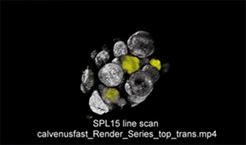Flowering at the right time: robust control of reproduction by age and environment
The success of plant and animal species depends on producing as many offspring as possible. However reproduction has costs for the parent and the offspring must have a high chance of survival. To maximize an organism’s breeding success, the timing of reproduction and the number of offspring produced are strongly selected during evolution.
In many plants and animals, mechanisms have evolved to ensure that reproduction occurs in spring in response to environmental cues. However, such environmental responses are not sufficient to explain the patterns of reproduction observed in nature. For example, most organisms go through a period of juvenility when they do not reproduce even if exposed to appropriate environmental cues. This delay ensures that the parental organism is prepared for the costs of reproduction, and is conferred by developmental programmes. A plant that reproduces too early in its life time will not survive to produce seeds or will produce fewer seeds. There is therefore a tension in the life cycle of every organism between the necessity to produce offspring and the requirement to time reproduction correctly in the context of the life of the parental organism as well as in the annual seasonal cycle. In plants the first stage of reproduction is the initiation of flowering, the decision to stop producing leaves and start forming flowers. In most species this step is irreversible and therefore to ensure that it occurs at the optimal time it is under complex regulation by environmental cues and developmental programmes. Two papers from the laboratory of George Coupland, a Director of MPIPZ, have recently added to our understanding of this process.
Hyun et al (2016) writing in Developmental Cell and studying the model plant species Arabidopsis thaliana identify a transcription factor that acts as an age-controlled switch to induce flowering. Strikingly, this protein, called SQUAMOSA PROMOTER BINDING PROTEIN LIKE 15 (SPL15), is a point of direct convergence of two developmental pathways long known to promote flowering. The SPL15 gene arose as part of a whole-genome duplication that occurred at the base of the Brassicaceae family giving rise to two closely related genes, SPL15 and SPL9. These genes have been retained throughout diversification of the Brassicaceae family, but Hyun et al show that they have evolved different temporal and spatial patterns of expression and have different functions. At the apex of the plant, SPL9 messenger RNA (mRNA) is expressed mainly after floral induction on the flanks of the shoot apex where flowers will form and was recently shown to have important functions in the early stages of flower development. By contrast, spl15 mutants are strongly delayed in floral induction and SPL15 mRNA is expressed before and during floral induction in the centre of the shoot apical meristem where the earliest steps of floral induction occur. However, Hyun et al show that presence of SPL15 mRNA is not enough for it to activate flowering but that rather two additional layers of regulation are imposed. First, SPL15 mRNA is targeted by a microRNA, miR156, which prevents expression of SPL15 protein. This miRNA was previously shown to fall in abundance as plants become older. Accordingly Hyun et al show that although SPL15 mRNA is present in the shoot meristem of young plants, its protein only accumulates in old plants when levels of miR156 fall. Thus SPL15 represents an age-related switch to flowering. In addition, SPL15 protein activity is controlled by another age-related factor, the hormone gibberellin. The level of this hormone at the apex increases as plants age, and when it interacts with its receptor it triggers the degradation of a class of proteins called DELLAs. Hyun et al show that DELLAs interact with SPL15 on gene promoters and prevent SPL15 from activating transcription of its target genes. However, in the presence of gibberellin, DELLA proteins are degraded allowing SPL15 to activate transcription of its target genes.
SPL15 protein marked with yellow fluorescent VENUS is expressed in the shoot meristem and axillary meristems of Arabidopsis tanhalia. Double click on the video to watch a 3D reconstruction of the shoot apex expressing SPL15-VENUS.
Hyun et al describe two target genes of SPL15, FRUITFULL and miR172b, both of which have known roles in promoting flowering and both of which depend on SPL15 activity for their activation when plants are grown in non-inductive short-day conditions. Thus this publication describes two layers of regulation of SPL15, a post-transcriptional mechanism involving the small RNA miR156 and a post-translational mechanism involving interaction with DELLAs, which combine to ensure that SPL15 only promotes flowering when plants reach a certain age. Interestingly they also show that in Arabidopsis thaliana this system is critical for flowering only in conditions where plants are not exposed to long day-lengths of spring, because when plants are exposed to these conditions SPL15 activity is no longer needed but is bypassed by another pathway. Hyun et al speculate that the balance between these day length and age related SPL15 pathways likely varies in different species, so that some are absolutely dependent on the age-related miR156 pathway, as shown previously for Arabis alpina, a perennial relative of Arabidopsis thaliana.
Fernández et al (2016) consider another aspect of flowering, robustness of the response to environmental cues. Many plants respond to the highly predictable cue of day length to ensure that flowering occurs at a particular time of year. Flowering is induced or repressed by exposure to particular day lengths, and such responses must be robust to fluctuations in other environmental parameters. However, as day length changes during the year other environmental parameters that influence flowering, such as temperature and light intensity, also fluctuate. Thus the response to day length must be robust to changes in these other parameters. Arabidopsis thaliana normally flowers rapidly under long day-lengths characteristic of spring and summer but flowering is delayed under short day-lengths characteristic of winter. However, if the temperature is increased from normal growth temperatures of 12-20°C to 27°C then flowering occurs rapidly even under short day-lengths.

Fernández et al demonstrate that this occurs because high temperatures enhance the activity of the photoperiodic flowering pathway under short days. Under lower temperatures this pathway is active only under long days, but when the temperature is increased this pathway promotes flowering under short days. In addition, the response to this pathway is enhanced at the shoot apex. Fernández et al describe a unique combination of mutations in three genes that abolishes the high temperature response. These mutations impair the output of the photoperiodic pathway encoded by the FLOWERING LOCUS T and TWIN SISTER OF FT genes as well as an inhibitor of flowering, SHORT VEGETATIVE PHASE, which acts at the shoot apex to repress flowering. They propose that loss of robustness of day-length response at high temperature is due to activation of the photoperiodic pathway at threshold levels under short days and loss of activity of an inhibitor of the response to the photoperiodic pathway at the shoot apex. These results suggest that the flowering behaviour of plants may change in unpredictable ways in response to climate change.
These papers provide a deeper understanding of how environmental and developmental pathways interact to control flowering and thus plant reproduction. They also provide a basis for further studies exploring how the balance of activity in these pathways changes during adaptation to different environments and as species diversify. Furthermore, agriculture depends on efficient plant reproduction and the consequent production of seeds in a broad range of environments and increased understanding of flowering patterns will be necessary to maintain and enhance yield.
More information:
Interview with the authors Youbong Hyun and René Richter in Developmental Cell Volume 37, Issue 3 2016.
Commentary on Hyun, Richter et al by Doris Wagner (Making Flowers at the Right Time, Developmental Cell Volume 37, Issue 3 2016).
Original publications:
Youbong Hyun, René Richter, Coral Vincent, Rafael Martinez-Gallegos, Aimone Porri, George Coupland (2016). Multi-layered regulation of SPL15 and cooperation with SOC1 integrate endogenous flowering pathways at the Arabidopsis shoot meristem. Developmental Cell 37, 254-266.
Virginia Fernández, Yasuyuki Takahashi, José Le Gourrierec, George Coupland (2016). Photoperiodic and thermosensory pathways interact through CONSTANS to promote flowering at high temperature under short days. The Plant Journal, accepted manuscript online: 27 April 2016 DOI: 10.1111/tpj.13183.

